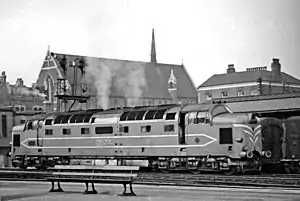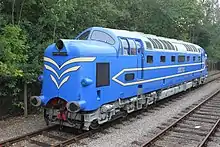| English Electric DELTIC prototype | |||||||||||||||||||||||||||||||||||||||
|---|---|---|---|---|---|---|---|---|---|---|---|---|---|---|---|---|---|---|---|---|---|---|---|---|---|---|---|---|---|---|---|---|---|---|---|---|---|---|---|
 DP1 at Harringay station in 1959 in blue livery. | |||||||||||||||||||||||||||||||||||||||
| |||||||||||||||||||||||||||||||||||||||
| |||||||||||||||||||||||||||||||||||||||
| |||||||||||||||||||||||||||||||||||||||
| |||||||||||||||||||||||||||||||||||||||
English Electric DP1, commonly known as Deltic, is a prototype 3,300 hp (2,500 kW) demonstrator locomotive employing two Napier Deltic engines, built by English Electric in 1955.
The high power of the locomotive at an acceptably low axleload resulted in 22 similar locomotives being ordered by British Railways for use on East Coast Main Line express passenger services, the serial production of which became the British Rail Class 55.
Background and design
.jpg.webp)
The English Electric company, which had absorbed the aeroengine-maker D. Napier & Son into its group at the instruction of the Ministry of Aircraft Production in 1942, was a major builder of diesel and electric locomotives. The two George Nelsons (Sir George, and his son, known in the works as "Half") saw the potential of Napier's Deltic engine for rail traction and in 1954–1955 built a demonstrator at its Dick, Kerr works in Preston. Officially numbered DP1,[lower-alpha 1] its internal project title was Enterprise, and it was intended that the locomotive would carry that name.[1] However, in 1954, before completion, Hudswell Clarke announced a range of small diesel-mechanical locomotives using the same name.[1][lower-alpha 2] After initial trials in 1955, the locomotive received the word Deltic in large cream capital letters on its sides, and the name became synonymous with the locomotive.[3]
Long aluminium beadings on the sides were painted cream, a visual device to make the locomotive's high sides appear more slender and add to the impression of speed. Three curved chevrons on each nose, in the same cream, added to that effect. To British eyes, the locomotive's bulldog nose styling was reminiscent of American locomotives, such as the EMD E-unit or ALCO PA designs (partly because English Electric initially planned to offer the type for export), with high noses and small, somewhat swept-back cab windows set behind them. To add to the American look of the locomotive, a large headlight was to have been fitted to each nose (the lights were never installed but would have been of the rotating 'Mars Light' type as fitted to North American locomotives of the era). Two 18-cylinder Deltic engines were fitted, derated from the 1,750 horsepower (1.3 MW) of the marine engines used in minesweepers to 1,650 horsepower (1.2 MW) each, generating 3,300 horsepower (2.5 MW) total. This derating reduced the stress on the engines, thereby increasing the service life and length of time between overhauls.
Service and testing

The locomotive first saw service on the London Midland Region of British Railways in 1955, generally operating fast London to Liverpool freight trains; it was withdrawn and after modifications re-entered services in 1956.[4] Tests were carried out on the Settle to Carlisle line in August/September 1956,[5][6][lower-alpha 3] after which it operated passenger trains, The Shamrock and The Merseyside Express, between London and Liverpool,[6][4] followed by London-Carlisle trains, and in 1957, returning to London-Liverpool trains.[6] The region's chief mechanical and electrical engineer, J.F. Harrison, rejected the design, believing high-speed engines (i.e. 1500 rpm) unsuitable for railway applications.[4][lower-alpha 4]
In 1957, Gerry Fiennes, the line traffic manager on the former Great Northern route out of London King's Cross station, was seeking high power locomotives to run services on the East Coast Main Line, having found the 2000 hp English Electric type 4 locomotives produced under the 1955 modernisation plan lacking sufficient power for his planned timings; as a consequence he proposed using 'Deltic' type locomotives on the line. Objections to the order included those arising from: a limited permitted top speed due to the mass of the locomotive; the potential for the order to delay a proposed (1957) electrification scheme of the line; as well as the size which required modifications to the King's Cross platforms. An order was placed in 1959 for 22 Class 55s to replace 55 steam locomotives.[4]
Preservation

.JPG.webp)
DP1 was in service until 24 November 1960 when a severe oil leak in one of the engines was discovered. The locomotive was sent to English Electric Company's Works at Newton-le-Willows, Lancashire the next day for repair.[7] However no repairs were sanctioned and the locomotive was withdrawn from service in March 1961 having completed 450,000 miles (720,000 kilometres).[7] Plans to test it in Canada fell through,[8] and the locomotive was donated in April 1963 to the Science Museum, South Kensington and placed on public display.[9]
After 30 years at the Science Museum, it was transferred to the National Railway Museum, York in October 1993.[10] About 11 years later it was moved north to the National Railway Museum Shildon, County Durham in July 2004.[7] In August 2012 it was loaned to The Ribble Steam Railway in Preston, Lancashire,[11] which is barely a mile away from where it was originally built, returning to Shildon in October 2015 [12] where it remains as of January 2023.[13]
Restoring the two Deltic engines installed in DP1 to running condition is not feasible. The engines (Type E158, D18-12) although similar, differ from those used in British Rail Class 55 locomotives (Type E169, D18-25B).[14] Aside from the original issue with the severe oil leak in the phasing gear cover, significant engine components were removed for use as spare parts for the Royal Navy prior to DP1 being donated to the Science Museum[15] as the locomotive was not owned by British Railways.[16]
Models
The Kitmaster company produced an unpowered polystyrene injection moulded model kit for 00 gauge. In late 1962, the Kitmaster brand was sold by its parent company (Rosebud Dolls) to Airfix, who did not release model kits of this locomotive. In time, the Airfix tools passed on to Dapol who rediscovered the moulding tools and have since produced the model kit.[17]
In 2007 model manufacturer Bachmann Branchline and the National Railway Museum announced the release of an OO scale model of the DP1 for sale at the NRM Shop. Bachmann used laser-scanning (see 3D scanner) of the machine at the National Railway Museum Shildon to collect dimensional data of the locomotive. The model was praised for its attention to fine detail and smooth and powerful running.[18] Bachmann released an N-scale model under the Graham Farish brand in 2010.[19][20]
In February 2023 Hornby announced a new diecast Dublo tooling in OO gauge of the Deltic prototype locomotive, English Electric DP1 'Deltic', fitted with sound (R30297TXS).[21]
See also
- British Rail DP2, a later prototype, with a single English Electric 16CSVT engine of 2,700 hp
Notes
- ↑ DP1, "Diesel Prototype 1";[1] this designation was never carried on the locomotive.[2]
- ↑ For the Hudswell Clarke engine 'Enterprise' see Applications of the Paxman Hi-Dyne engine. Plans to name DP1 Enterprise never came to fruition.[3]
- ↑ Tests on the Settle Carlisle line using two mobile testing units and a dynamometer car were published in the British Transport Commission Test Bulletin No.19.
- ↑ The West Coast Main Line was subsequently electrified, starting in 1959.
References
- 1 2 3 Webb 1982, p. 5.
- ↑ Marsden, Colin J (November 1984). BR Locomotive Numbering. Shepperton: Ian Allan Publishing. p. 18. ISBN 0-7110-1445-0. EX/1184.
- 1 2 Webb 1982, pp. 5–6.
- 1 2 3 4 Johnson, John; Long, Robert A. (1981). Bond, Roland C. (ed.). British Railways Engineering 1948–80. Mechanical Engineering Publications. pp. 175–176. ISBN 0852984464.
- ↑ Webb 1982, p. 8.
- 1 2 3 Cock 1958, p. 741.
- 1 2 3 "DELTIC - 1960". Deltics: Chronicles of Napier. Archived from the original on 26 October 2020. Retrieved 26 October 2020.
Eastern region Diesel Locomotive Panel Minutes of meeting held 25th November 1960
- ↑ Webb 1982, p. 11.
- ↑ "Presentation of Deltic locomotive to Science Museum, London". The Railway Gazette. Vol. 118. 24 May 1963. p. 573.
- ↑ "Deltic Breaks Out". The Railway Magazine. No. 1112. December 1993. pp. 5–7.
- ↑ "Prototype Deltic at RSR". Ribble Steam Railway and Museum. Archived from the original on 27 October 2020. Retrieved 27 October 2020.
- ↑ "Ribble Steam Railway - English Electric DP1/1955 Deltic Prototype". Archived from the original on 4 December 2014. Retrieved 27 November 2014.
- ↑ "English Electric Company diesel electric locomotive 'Deltic' Co-Co 3300HP, 1955". Retrieved 24 January 2023.
- ↑ "Napier Deltic Opposed-Piston Diesel Engine". Old Machine Press. Archived from the original on 27 October 2020. Retrieved 27 October 2020.
- ↑ "English Electric Company diesel electric locomotive 'Deltic'". Science Museum Group. Archived from the original on 27 October 2020. Retrieved 27 October 2020.
- ↑ Stuart Black (2017). Loco Spotter's Guide. Osprey Publishing. p. 100. ISBN 978-1-4728-2048-8.
- ↑ Knight, Stephen (1999). Let's Stick Together: An Appreciation of Kitmaster and Airfix Railway Kits. Clopthill: Irwell Press. pp. 7, 9, 41, 46, 66. ISBN 1-871608-90-2.
- ↑ Blythman, David; Teggin, Doug (February 2008). "Bachmann NRM Prototype Deltic". modelrailforum.com. Archived from the original on 27 March 2013.
- ↑ Hammond, Pat. "Graham Farish Prototype Deltic Locomotive DP1 372–920". Model Railway Express. Archived from the original on 24 December 2013.
- ↑ Bayer, Gareth (23 November 2010). "Grafar's 'magnificent seven'". Rail Express. Archived from the original on 24 December 2013. Retrieved 23 December 2013.
- ↑ "R30297TXS Hornby Dublo: BR, English Electric DP1, Co-Co, DP1 'Deltic' - Era 4 (Sound Fitted)".
Sources
- Cock, C. M. (1958). "The Deltic locomotive". Journal of the Institution of Locomotive Engineers. Institute of Mechanical Engineers. 48 (1958): 723–757. doi:10.1243/JILE_PROC_1958_048_066_02.
- Webb, Brian (1982). The Deltic Locomotives of British Rail. Newton Abbot: David & Charles. ISBN 0-7153-8110-5.
Further reading
- Marsden, Colin J.; Fenn, Graham B. (1988). British Rail Main Line Diesel Locomotives. Sparkford: Haynes. pp. 14–17. ISBN 9780860933182. OCLC 17916362.
- "'English Electric' "Deltic" Diesel-electric locomotive 3300 H.P. – type Co–Co" (company brochure). English Electric.
- "3300 H.P. Diesel-Electric Main Line Locomotive" (PDF). The Engineer. Vol. 200. 4 November 1955. pp. 653–4.
- Nock, O.S. (11 July 1958). "Performance and Efficiency Tests on the 3300 h.p. "Deltic" Locomotive" (PDF). The Engineer. Vol. 206. pp. 60–63.
External links
- "Deltic (DP1)". napier-chronicles.co.uk., full work history
- Picture of DP1 on test on S&C line